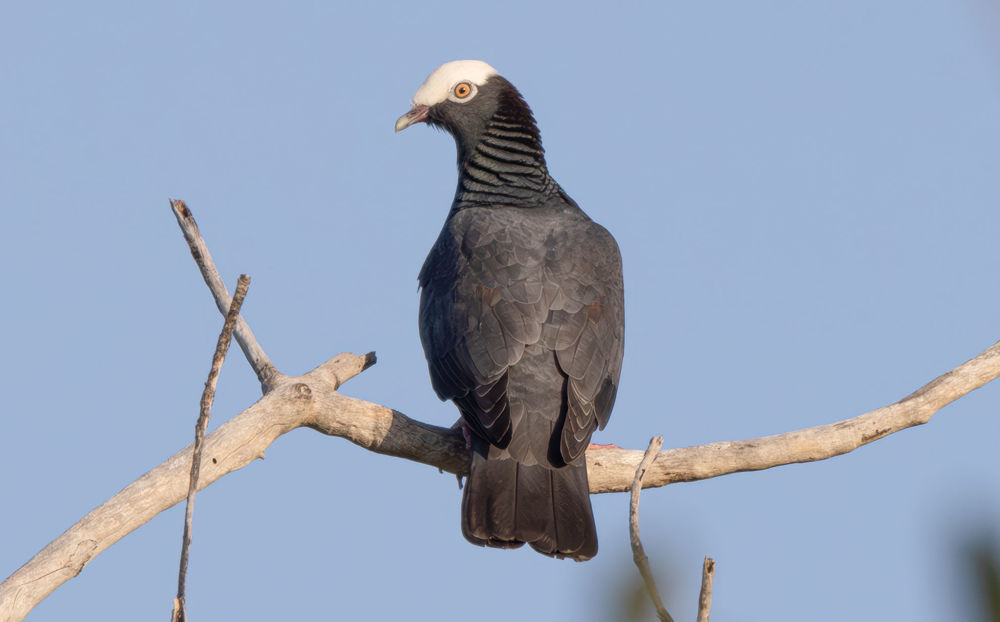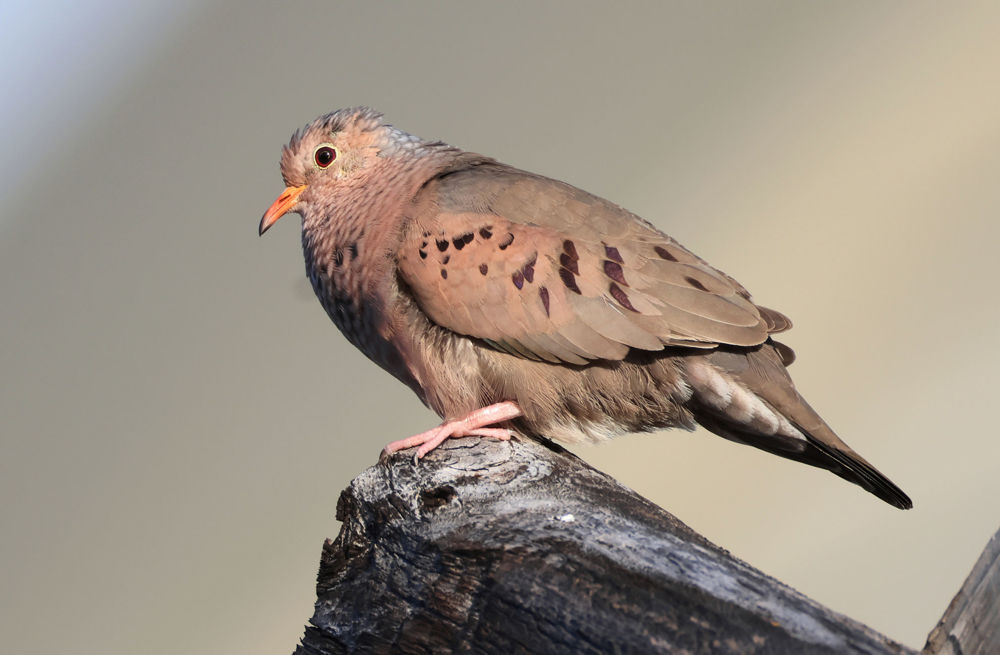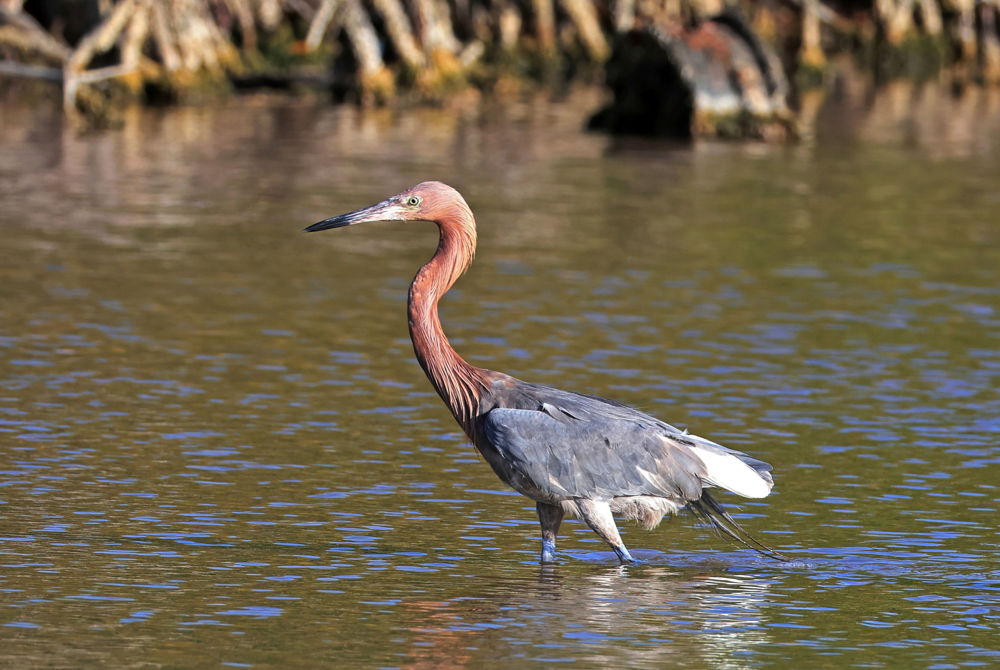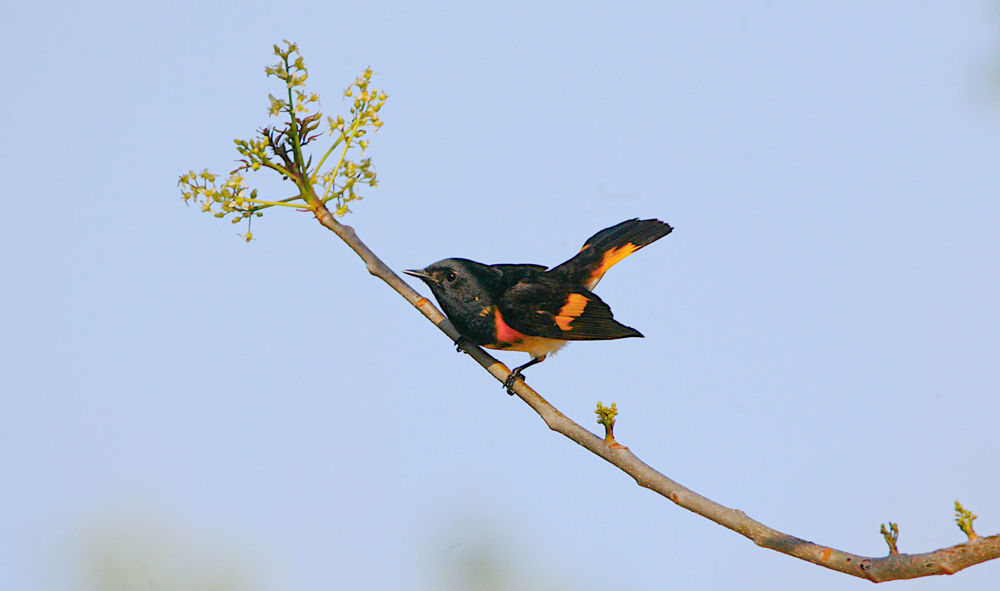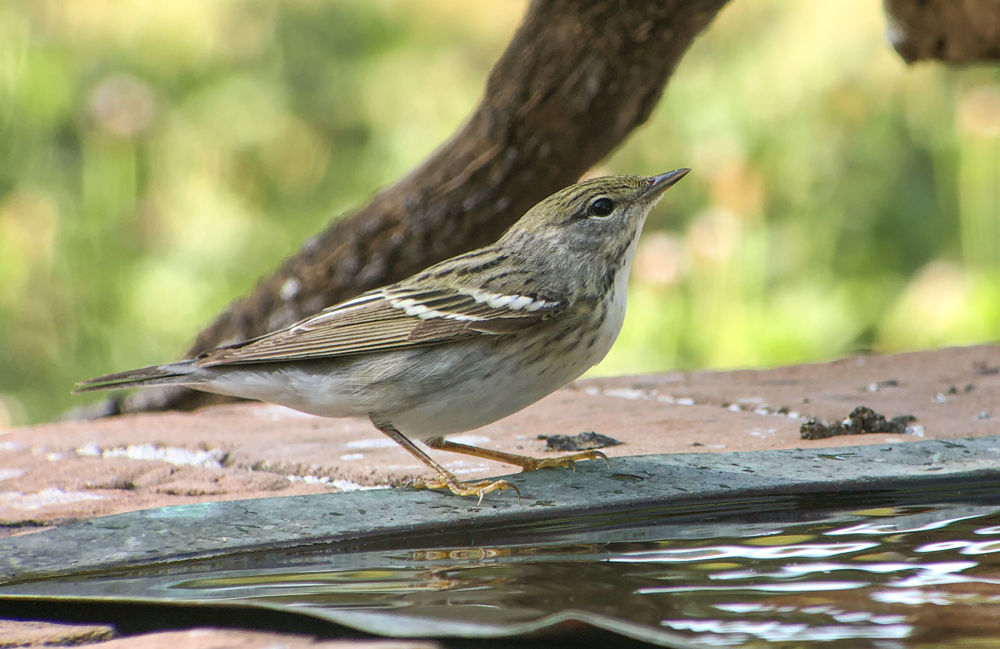Departure Date: April 27 - 30, 2025
Compiled By: Rafael Galvez
Trip Leaders: Rafael Galvez
Toll Free: 800.328.8368
Phone: 512.328.5221
Dry Tortugas 4/27/2025-4/30/2025

After more than a week of winds out of the south persistently blowing over South Florida, the weather finally calmed in time for our 2025 Dry Tortugas tour. Starting with our brief time spent in Key West as a group, through our ride out 70 miles into the Gulf of Mexico, and for the duration of our time in the islands, the winds nearly halted, granting us a rewarding and safe passage during which we saw plenty of birds. The boobies stole the show, the terns and noddies kept us on our feet, the frigatebirds were on display, and the migrating warblers kept us searching.

Red-footed Booby © Laura Erickson
During our first night together, we had dinner at El Siboney, an authentic Cuban restaurant in Stock Island, giving us a flavor of South Florida’s diversity. For sundown, we drove a few miles to Geiger Key and stopped at Boca Chica Beach. With a view of the ocean to one side, and the Naval Air Base’s runway to the other, we scanned the area for birds. In the golden light of the lowering sun, several restless shorebirds could be seen, blending in with the heaps of weeds along the wrack line. There were some Black-bellied and Semipalmated plovers, a couple of Willets and some Ruddy Turnstones, and plenty of peeps including Sanderlings, a few Semipalmated, and mostly Least sandpipers. A Common Ground Dove fed near us, and Yellow-crowned Night Herons and Reddish and Snowy egrets found their roosts for the night. Our eyes were kept fixed on the sky, hoping for one event in particular, the arrival of Antillean Nighthawks to the island. A week earlier, most of us having taken part in the South Florida & The Keys tour had visited this same location but had heard no nighthawks. However, this night was different, and before long we heard the diagnostic staccato calls of Antillean Nighthawks over the runway, and could see the birds speeding in long flights, hawking for insects in fast sweeps! Afterwards, we embarked on the MV Makai, met the captain and crew, and after a brief orientation we all settled into our respective bunks for the night.
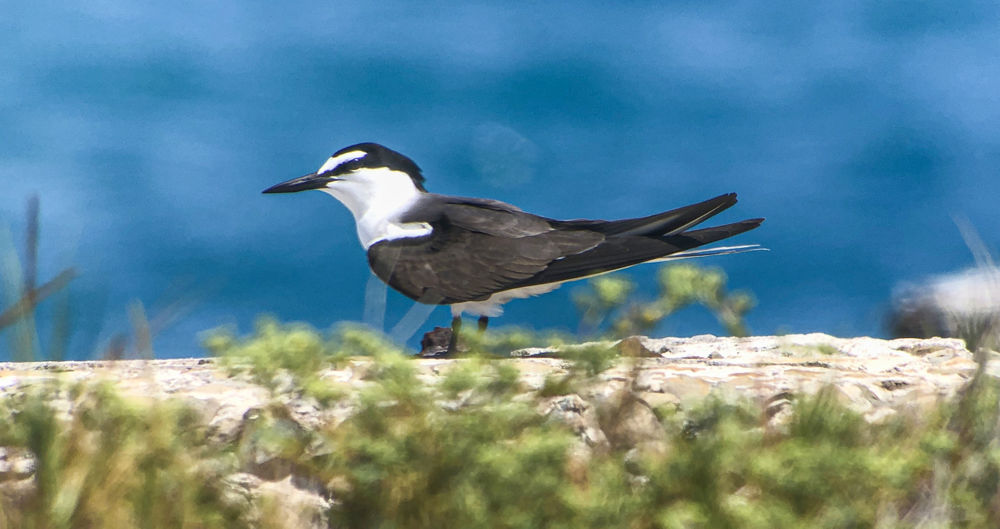
Bridled Tern © Rafael Galvez
By the time most of us had awakened the following morning, the Makai was already making its way out across the Florida Straits. It did not take long for us to be rewarded with the first of our exciting seabirds—Northern Gannets on the move, mostly young birds. The species winters off the coast of Florida. After a very nice breakfast, we all made our way out on the deck—it was nice and sunny, and the breeze felt cool. Flying fish could be seen flushing off the bow and gliding for long distances across the deep blue waters. Eventually we started seeing bands of Sargasso (Audubon’s) Shearwaters moving fast, some of which had to be detected at a distance, yet with some patience were eventually observed quite close to the Makai. This small shearwater of the tropical Atlantic is generally solitary, and during most circumstances we are fortunate when we see a few. Our persistence paid off, and by the early afternoon when we entered the national park boundaries, we had already tallied more than 40, in addition to 12 Northern Gannets, several Brown Boobies, and various tern species. Most remarkable was how we managed to see, far out into the Gulf and nowhere near land, several swallows including Bank, Barn, and Cliff, and even some migratory warblers on the wing including American Redstart and Cape May. Other highlights during our ride out to the islands included Loggerhead Sea Turtles and Bottlenosed Dolphins.

Brown Noddy © Laura Erickson
The crew often keeps a fishing line out the stern in hopes of a fresh catch for dinner. By mid-morning the line was being tugged, and one of the crew members asked Bill—one of the members of our group—if he wanted to lure the fish in. Bill worked on the line for some time, giving it persistent tug and muscle until finally he pulled in a beautiful 3’ Mahi-mahi!
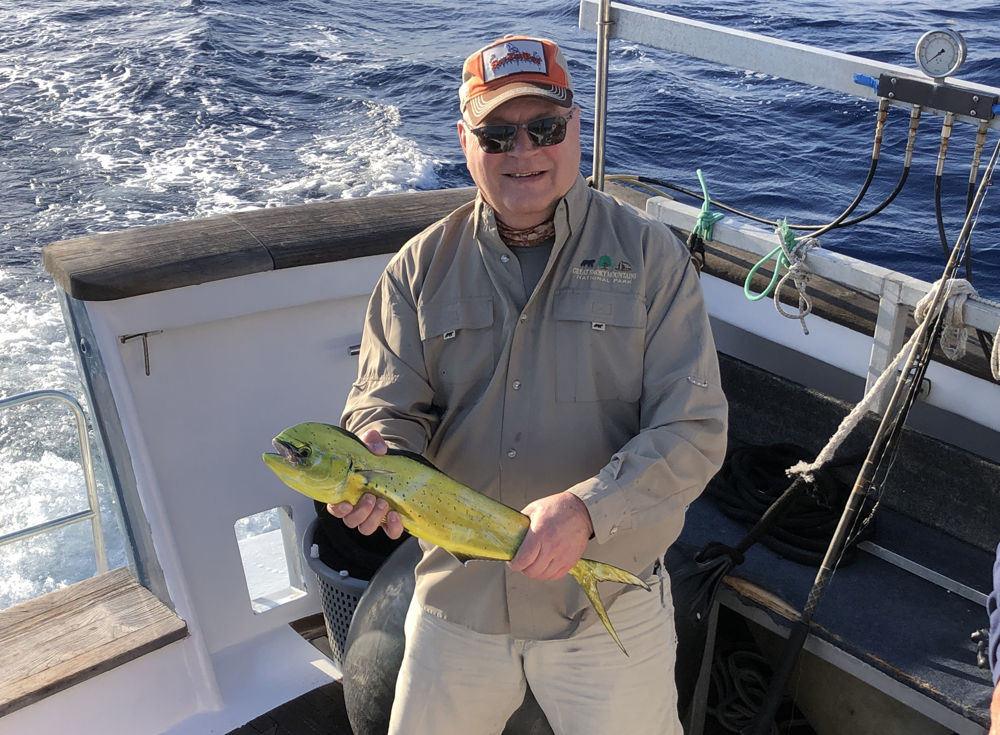
Bill with a Mahi-mahi © Rafael Galvez
Eventually, Fort Jefferson was visible as a distant brick behemoth over the horizon. Touted as the largest masonry structure in the U.S., this fort has had quite a dappled history, from war fortification to citadel for pirates, then a prison, a monument, and now part of a national park. It occupies nearly the entirety of Garden Key. Despite the tremendous importance of these islands as colonies for several species of birds and turtles, the park service continues emphasizing the perpetual mending of the dilapidated brick relic over all other efforts. And no doubt, its history is important, and the fort should be preserved. However, as a national park, the archipelago is most valuable as host to seabird species that nest nowhere else in the continental U.S. As many as 80,000 Sooty Terns and 5,000 Brown Noddies return each spring to breed and raise their nestlings among the seven islands. Additionally, Roseate and Bridled terns in much smaller numbers nest there too. And although Magnificent Frigatebirds are seen throughout the Gulf, within the U.S. they nest only in the Dry Tortugas. And who can forget the Masked Boobies that also nest in the archipelago. Roger Tory Peterson once wrote that the thousands of seabirds breeding in the Tortugas were “the number one ornithological spectacle on the continent.”
Once within the protected waters, we pulled up as close as possible to East Key as the Makai could. For many years, the Masked Booby colony was entirely in Hospital Key, two islands to the west. Likely due to the ever-changing size of these small coralline islands from storms and tides, the boobies are now nesting on East Key, and this proved to be more advantageous for us. As we approached the key, slowly navigating the shallow waters, we could see roughly 75 Masked Boobies and several Brown, resting on the sand. Soon, some of them could be seen flying in and out of the key, with several incursions directly over us, granting us unparalleled views of these endearing birds. We could not have gotten closer flyovers. These were lifers for many on the tour, and a much-anticipated moment! A Magnificent Frigatebird also came in to participate; sweeping in much larger than the boobies, it harassed a young Masked with agility in hope of stealing some food.
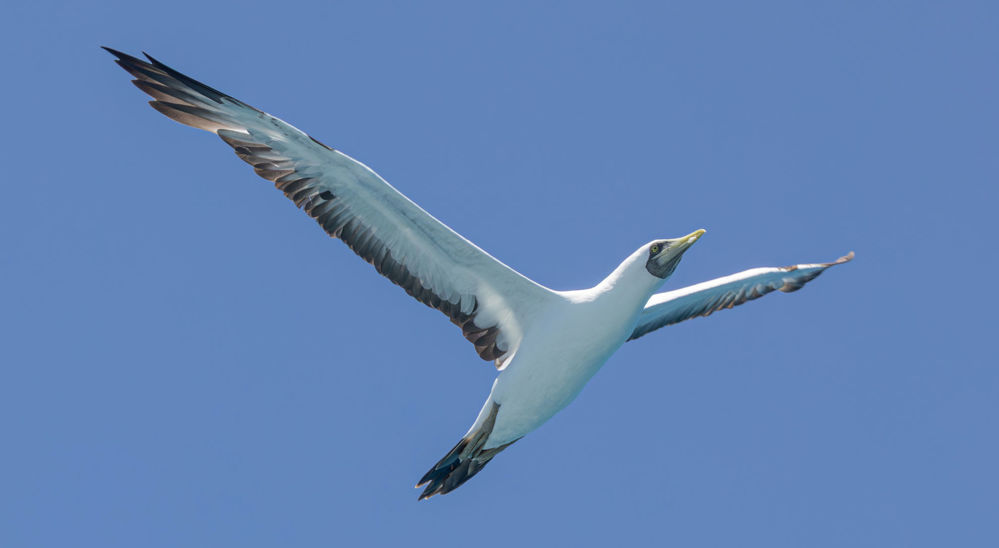
Masked Booby © Laura Erickson
Interestingly, a pair of Northern Harriers were seen flying off over open water from behind East Key towards the fort, foretelling the raptors we would find upon disembarking. As we finally pulled into Garden Key, where Fort Jefferson is located, we were surrounded by swarms of thousands and thousands of sea birds, primarily Sooty Terns, Brown Noddies, and Magnificent Frigatebirds hanging overhead. Upon disembarking, we wasted no time and started making the rounds to the coaling docks outside the fort’s moat to scrutinize the terns and noddies, and eventually into the fort’s Parade Grounds, to peer into the stands of Seagrapes and Buttonwoods for migratory birds. The birds we hoped for were Bridled and Roseate terns, and potentially a Black Noddy.
The Dry Tortugas, as the name suggests, have no natural freshwater source. There is limited vegetation on the islands to offer migrants shelter and food. When adverse weather intercepts birds during their nocturnal voyages as they are crossing the Gulf of Mexico towards the U.S. mainland, migrants may drop down on the islands to refuel as the weather improves. Some birds may be forced to remain in the Tortugas for some time, while new ones may be arriving at any given point. The perceivable arrival of birds at most migration stops tends to be best in the mornings, but seeing that these islands are deep into the Gulf, the arrival of migrants could be at any time.
VENT's tour to the Dry Tortugas is special in that we get to spend an extended period of time traveling to the archipelago and within the islands. Rather than rushing to and from Fort Jefferson in a single day via the ferry, we benefit from the flexibility that the MV Makai offers, particularly in allowing us to pursue pelagic species on our ride out, and allowing us to sail close to the Masked Booby colony. It also gives us the option to take intimate dinghy rides along the tern and frigatebird colonies, which are always magical. Birding Garden Key during several lengthy sessions in and around Fort Jefferson is never a disappointment.
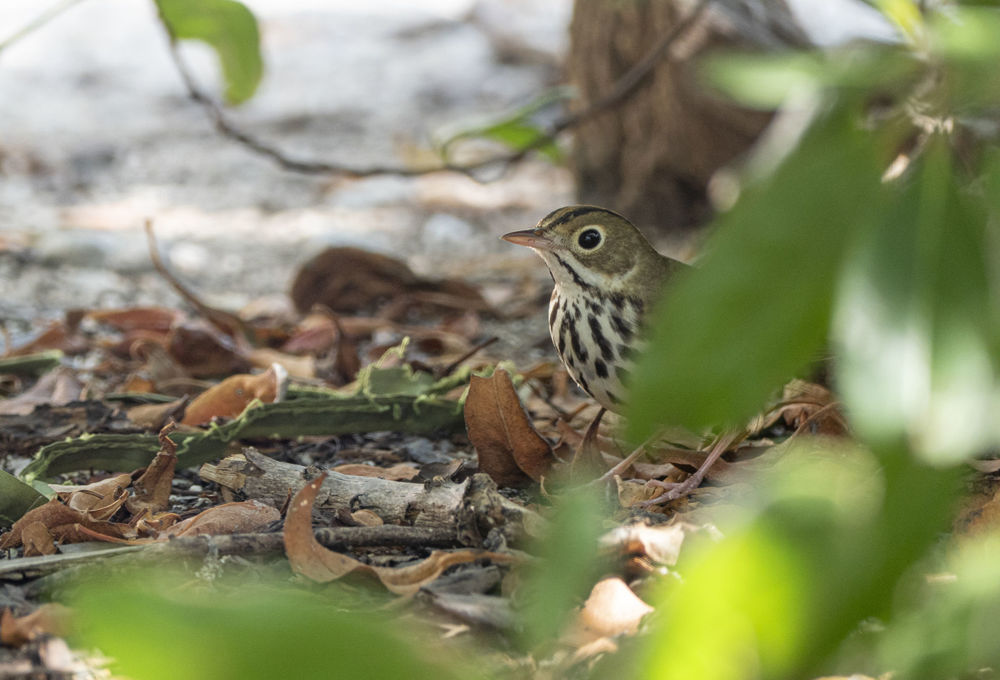
Ovenbird © Rafael Galvez
Our first visit to the northern coaling docks rewarded us with our first views of beautiful Roseate Terns, in addition to stunning views of velvety Brown Noddies. Sooty Terns by the thousands could be seen landing at arm’s length, some of them tending to their chicks below clumps of Sea Lavender. There had been word of a Black Noddy hanging around the countless Browns, but as much as we scrutinized each, one was not yet to be found. Down at the southern coaling docks, we were very fortunate to find several Bridled Terns calmly resting and interacting with one another. What a pleasure it was to admire such elegant terns at length! It isn’t always that we find them on land.
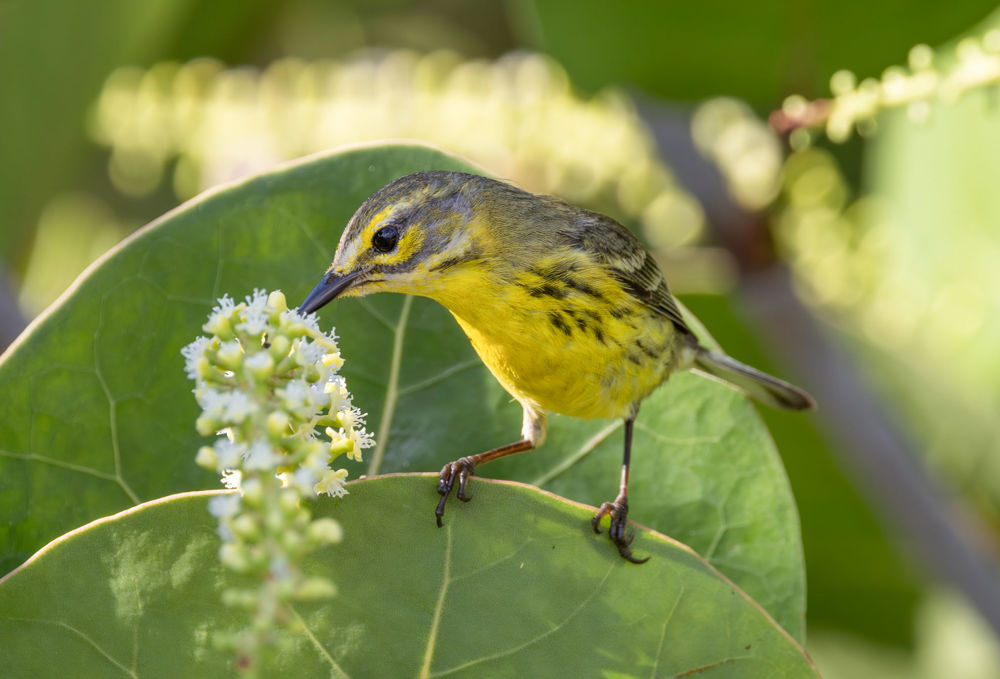
Prairie Warbler © Laura Erickson
Outside of the fort, the contour of the island has stands of Buttonwoods (Conocarpus erectus) and Seagrapes (Coccoloba uvifera). Inside the fort, the parade grounds host a few large hardwoods that offer shelter and foraging opportunities for migratory birds. A small fountain with fresh water was added decades ago and is a magnet to warblers and many other songbirds, and a good strategy is to simply wait by it for birds to come in and drink. In the parade grounds, we saw numerous American Redstarts, Cape May, Black-and-white, Northern Parula, and Palm warblers. Upon arriving, we immediately noticed some migratory raptors, including the pair of Northern Harriers, Sharp-shinned Hawks, Merlins, American Kestrels, and a Broad-winged Hawk. There were several swallows of four species, including Bank and Cliff, gliding about. A pair of Gray Kingbirds chased along the fort’s brick façade. Cattle Egrets grazed over the grasses, and Turkey Vultures waited shyly for an opportunity to drink. During our first afternoon on the islands, after a good effort in covering and scrutinizing every wooded niche, we found eight warbler species, including Black-throated Blue and Magnolia. Back on the Makai, dinner was ready for us, and as always, Rachel, our cook, did a fantastic job. Absolutely deliciously prepared food!
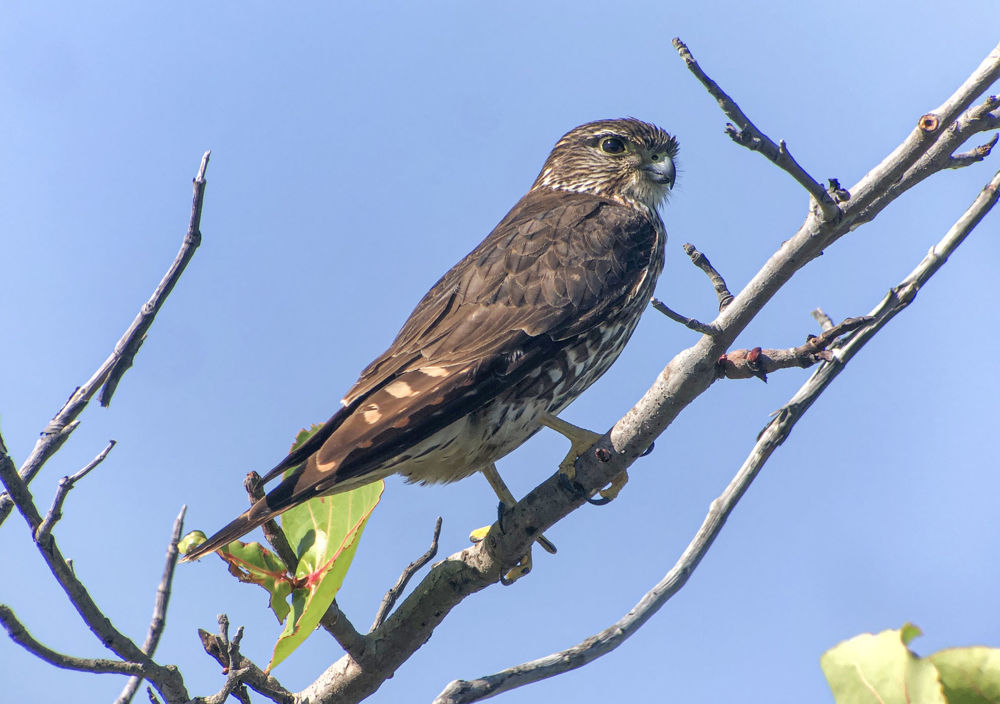
Merlin © Rafael Galvez
The following day, we spent several more hours on Garden Key, disembarking soon after breakfast and returning after a good lunch. Off the bat, we managed to add six more warbler species to the mix, including Northern Waterthrush, Hooded, Blackpoll, and Prairie warblers. After checking over the thousands of birds on the noddy colony, from the ground and from the top of the fort, it seemed almost impossible that a Black Noddy would turn up! Maybe there had been one among the thousands of Brown Noddies, but with the constant mass flights and rearranging, there was always the possibility that the bird was no longer there. The afternoon was coming to an end, and eventually we all came to rest on the benches by the water fountain. Blackpolls and Palm warblers came to drink and bathe, Redstarts flushed in and out, a single Myrtle (Yellow-rumped) made an appearance, and a very drab young female Cape May gave us pause—a tricky plumage. With almost no time left, one last round checking for noddies presented a different strategy in searching across the moat from the second floor, looking through the large cannon windows. And surprisingly, there, visible through a little hole deeper into the lavender bushes, a Black Noddy could be seen! Success! We all gathered to admire the smaller, darker, noddy with a relatively longer bill and a whiter cap.
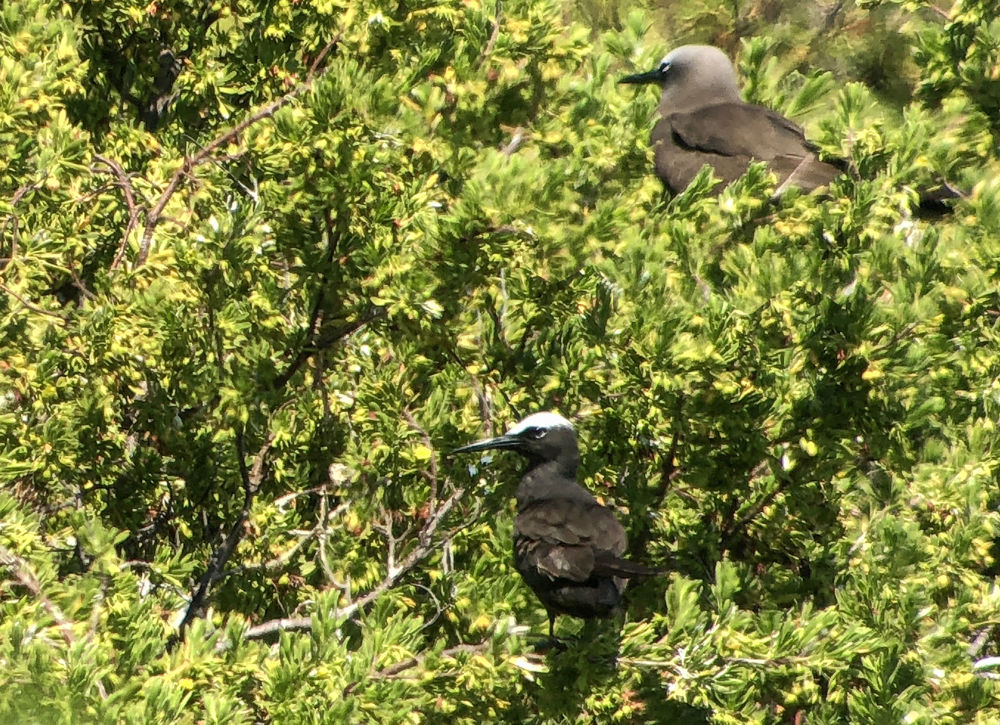
Black Noddy below a Brown Noddy © Rafael Galvez
We had reserved one of the highlights of the tour—the dinghy runs along Bush and Long Keys—for sunset during our final evening in the Tortugas. This allowed us to get closer and more personal with the breeding noddies, terns, and especially the Magnificent Frigatebirds, which occupy an island inaccessible by foot. As we were getting ready to board the dinghy, we were scoping a Peregrine Falcon on Long Key from afar. It then took off and flushed most of the frigatebirds, which then flew a few circles and returned to their roosts, and among them, a “red-footed” bird landed atop one of the trees. The red cherry to top off the tour was upon us, and we took the dinghy to confirm that a Red-footed Booby—seldom seen in these waters—was our final addition to the list—and a fine one indeed! As we rode gently past these islands, thousands of terns and noddies streamed by in a dizzying parade. As we slowed by Long Key, we could see countless Magnificent Frigatebirds hanging effortlessly over the mangroves; some of the perched males had their bright red gular pouches inflated and displaying! After careful inspection, we could see nestlings of various ages, some fluffy-white still in their stick nests, and others partly downy, nearly the size of their parents. As the sun was setting, turning the sky all kinds of colors, we ran back to the Makai, ready for another delicious dinner.
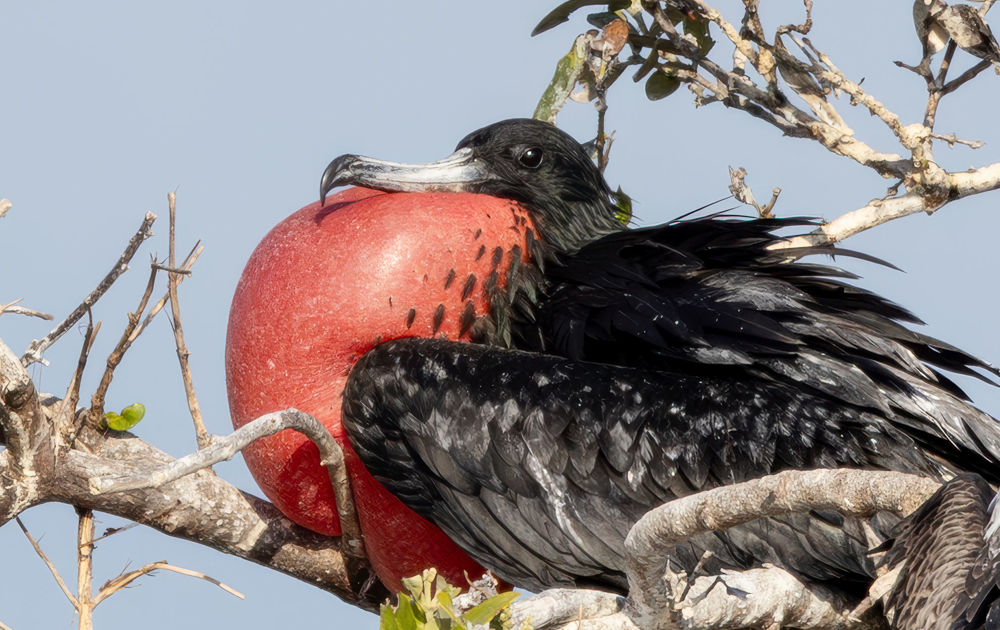
Magnificent Frigatebird © Laura Erickson
Our return to Key West was substantially “sportier” than our ride days earlier, as the sea was quite choppy and we had to travel into the wind. As a result, we saw relatively few birds and kept a low profile inside the Makai. Aside from the return, we were fortunate to have impeccable weather the entire time we were out there, and the crew kept us safe and fantastically well fed. We shared many beautiful sights, several uncommon birds, and each other’s company during a true island birding adventure.
Voted Favorites
- Red-footed Booby – It was unexpected and awesome!
- Masked Booby – A much anticipated lifer for most!
- Magnificent Frigatebird – Displaying with their inflated pouches!
- White-crowned Pigeon – A stunning bird seen well.
- Sargasso (Audubon’s) Shearwater – Though not seen well, seen often, and a lot of fun to track down!
A complete list of the birds recorded on our trip can be found at:
https://ebird.org/tripreport/373252
Read the description for the next departure of this tour.
View Rafael Galvez's upcoming tour schedule.
ITINERARY:
April 27 – We met for a tour orientation at the Doubletree Grand Key Resort at 5 p.m., followed by dinner at El Siboney Cuban Restaurant on Stock Island. After a very nice meal by the ocean, we drove eastward, leaving Key West and visiting Boca Chica at sundown. We then drove to the marina back on Stock Island to board the MV Makai, where we spent the night.
April 28 – The Makai departed from harbor before sunrise. After breakfast we spent our time on the outer deck, birding along the way. We made a stop by the Masked Booby colony on East Key and enjoyed excellent views. Arrival at Garden Key by early afternoon. We birded the Fort Jefferson parade grounds and Garden Key through the afternoon.
April 29 – We disembarked at Garden Key early in the morning and birded until midday, when we took a break for lunch. We returned to Garden Key in the early afternoon. At sundown, we took dinghy rides along Bush and Long Keys. We spent the night docked off Garden Key, in the Dry Tortugas.
April 30 – After breakfast at sunrise, we disembarked the Makai and spent some time birding in and around the fort. Once back aboard the Makai we started our return to Key West. We returned to harbor my mid-afternoon. The tour ended with a transfer back to the Doubletree Grand Key Resort.
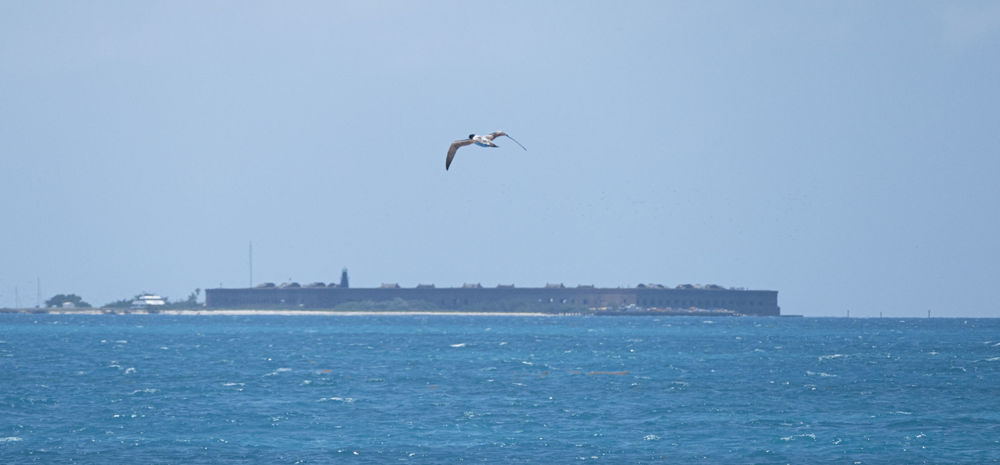
Masked Booby and Fort Jefferson © Rafael Galvez
Note: Species in underlined print are of limited distribution in the region, and/or ABA countable only in this region, or are otherwise generally hard to find. Species in underlined bold print are vagrants or quite rare in the region. ( I ) indicates introduced species. ( E ) indicates endemic to the region.

